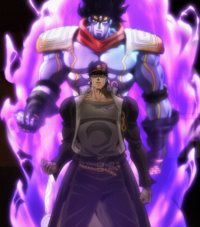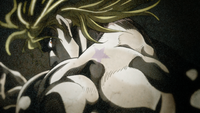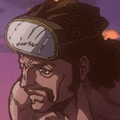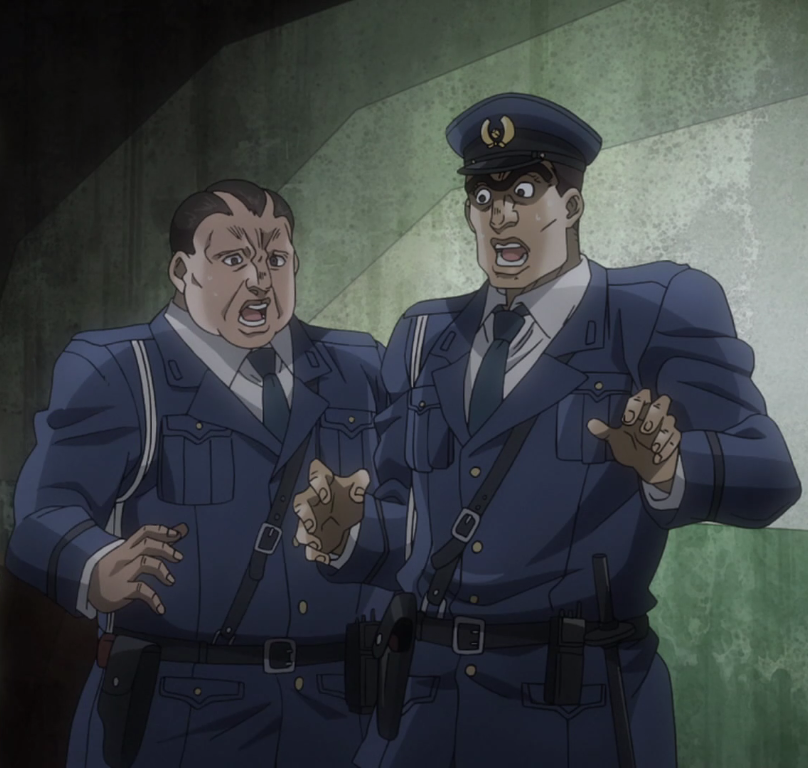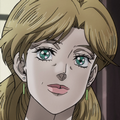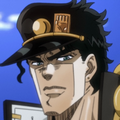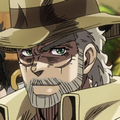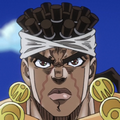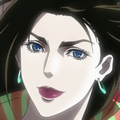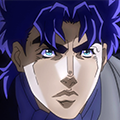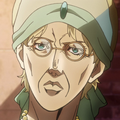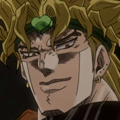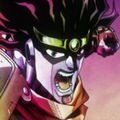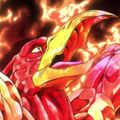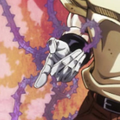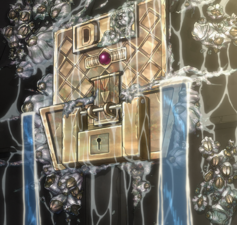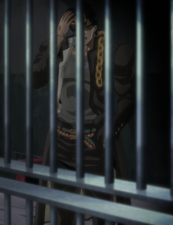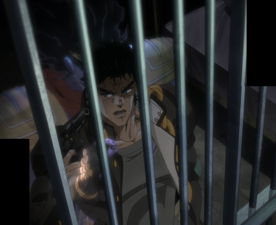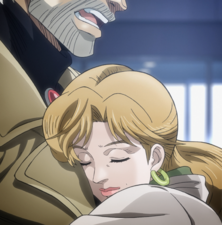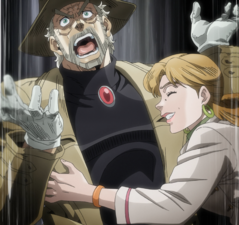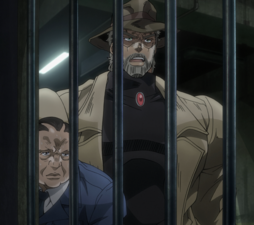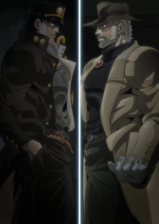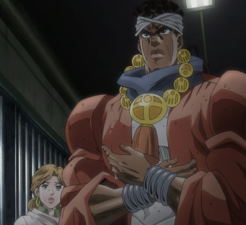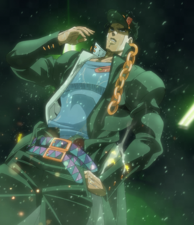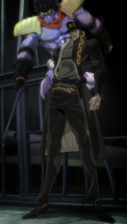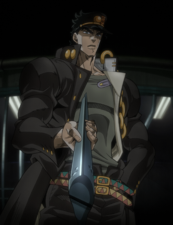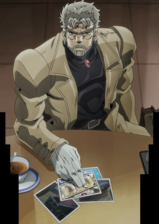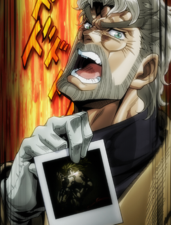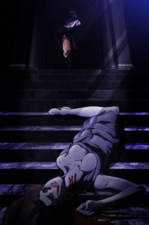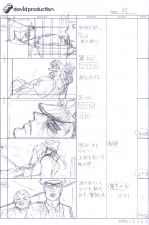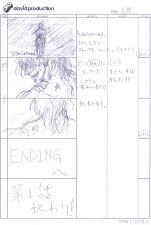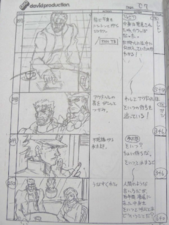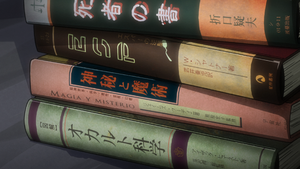Stardust Crusaders - Episode 1
In the year 1987, Joseph's Japanese grandson Jotaro Kujo discovers that he is "possessed" by an evil spirit. Joseph and the fortune-teller Muhammad Avdol visit him in Tokyo and reveal to him the existence of the power called "Stand". Meanwhile, an ancient evil has returned.
Summary
Several years after the events of Part 2, a group of treasure hunters retrieves a coffin from the water off the coast of Africa with the name DIO written on it. Sometime later, the boat is discovered by the Speedwagon Foundation void of its passengers, though the coffin had been found empty.
In the year 1987, 17-year-old delinquent, Jotaro Kujo, grandson of Joseph Joestar, is sent to prison after beating up three armed men and a trained boxer. Despite Holy's insistence, he refuses to leave, claiming that he is possessed by an evil spirit. To demonstrate, he takes a prison guard's gun and shoots himself in the head, but the bullet is stopped by a mysterious floating arm that only he and his mother can see. Holy mentions that his grandfather also possessed similar powers. Joseph arrives in Japan with a mysterious partner and is greeted by Holy. The three head to the prison, where Joseph confronts Jotaro and asks him to leave the jail cell. Jotaro refuses at first due to his "evil spirit" and takes the pinky off Joseph's prosthetic hand. Joseph reveals his partner to be an Egyptian fortune teller by the name of Muhammad Avdol, who also reveals a spirit of his own. Avdol's spirit manifests itself as a humanoid with a bird-like head and the ability to produce flames. The spirit launches a projectile of flames causing Jotaro to get pinned against the back wall of the jail cell. Having no other choice, Jotaro releases his spirit and briefly engages Avdol, but not before the latter halts the fight after pointing out that he had accomplished his goal of removing Jotaro from the cell.
The group leaves the prison and, at a local cafe, Joseph demonstrates using his Stand, Hermit Purple by creating an image of DIO by smashing a camera. He tells the group that the sudden appearance of their strange manifestations had erupted from the recent resurrection of the Joestar arch-nemesis, Dio Brando, who is now referred to simply as DIO. Joseph also reveals that this link is due to the fact DIO had managed to take over Jonathan's body. Nonetheless, Jotaro barely believes Joseph’s story, even with the proof he had made. Somewhere else, DIO lies in the shadows fully aware that the group had been watching him with Joseph's Stand. DIO walks off mentioning that while this may be fate, he had already prepared to take care of the Joestars.
Appearances
Credits
芦谷耕平
Yuji Tsuchiya
Yoshinobu Ando
Yuzuru Jogashima
Etsushi Mori
Masahiko Komino
Hiroshi Tanabe
Ryousuke Senbo
Masato Hagiwara
Kimitaka Ito
Megumi Honda
Kohei Ashiya
Akie Muratsukasa
Shunji Suzuki
Toshiharu Sugie
Ryozo Sugiyama
Takenori Tsukuma
Hideyuki Sugiura
Megumi Itoi
Manabu Imura
Yuriko Ishii
Shinpei Koikawa
Hiroshi Tatezaki
Masashi Nomura
土屋 友次 (Key)
安藤 義信
城ヶ 島譲
森 悦史
小美野 雅彦
田邉 博
泉保 良輔
萩原 正人
伊藤 公祟
本多 恵美
芦谷 耕平
村司 晃英
鈴木 俊二
杉江 敏治
杉山 了蔵
津熊 健徳
杉浦 英之
糸井 恵
井村 学
石井 百合子
鯉川 慎平
館崎 大
野村 雅史
西村 彩
Megumi Tonegawa
Kaori Saito
Yuu Kaneshiro
Keiko Watanabe
Takayuki Nakao
刀根 川恵
斉藤 香織
金城 優
渡辺 恵子
中尾 高之
Sinaion
Snowdrop
Studio Toy Box
Studio GAO
SINAION
(株式会社スノードロップ)
スタジオToy Box
スタジオGAO
渡辺 藍希
檜垣 賢一
Music
Manga/Anime Differences
- Rather than appearing at the end, the discovery of DIO's coffin appears at the beginning of the episode.
- A scene is added, showing Holy talking to officers in the police station before they escort her to Jotaro's cell.
- In the anime, Jotaro is seen reading Baoh in his cell instead of Shonen Jump. This is much like when Joseph reads it in the first episode of the adaptation of Part 2.
- In the anime, when Jotaro is pinned against the wall by Magician's Red's Red Bind, he kicks a table that hits a toilet and frees himself. In the manga, Jotaro kicks the toilet itself.
Commentary
To be precise, one must know that an anime uses three different frames for lips synchronization. For this episode, we went up to four frames. This is extra work for the key animator, for an ultimately discrete result. We then went back to normal for the remainder of the series, except the close-ups chosen by the director.
With this series, we sought to reach a Western aesthetic by observing animation processes used in foreign series and movies. In fact, to apply too many "anime-esque" tropes would have worked against JoJo. It was already the case in the first series, but some motions were still not realistic enough. The goal of this season was thus to improve this aspect as much as possible.
Regarding the animation, we had to manage 12,000 drawings like madmen. That was crazy. (laughs) But the benefit (if there was any?) was mainly towards Magician's Red's flames. In the end, everyone survived (laughs), and I am very satisfied with the first episode. It is a major work and a long series, and we had to jump into the fray and have a good start. Mission accomplished.Gallery
Trivia
- The books that Jotaro read in his cells are inspired by real life books and real-life people.
- The Book of the Dead (死者の書, Shisha no sho) by Ginobu Orikuchi (折口疑夫, Orikuchi Ginobu). It is inspired by The Book of the Dead by Shinobu Orikuchi.
- ESP: esper's counterattack (ESP エスパーの逆襲, Esupu esupā no gyakushū), authored by W. Shatner (W・シャトナ, W shatonā) and translated by Joji Takei (武井乗児, Takei Jouji). The author and translator are inspired by William Shatner and George Takei who played in the TV series Star Trek. The title of the book itself is inspired by the movie Star Trek II: The Wrath of Khan's Japanese title: "スタートレックII カーンの逆襲".
- Mysteries and Magic (神秘と魔術, Shinpi to majutsu) by James Houdini (ジェイムズ・フーディニ, Jeimuzu Fūdini) and translated by Atsuko Amarata (粗股宏子, Amarata Atsuko). James Houdini is inspired by Harry Houdini.
- Occult Science (オカルト科学, Okaruto kagaku) by Issac Houston (アイザック・ヒューストン, Aizakku Hyūsuton) translated by Junsan Nirasawa (韮沢潤三, Nirasawa Jyunsan). The author and translator are inspired by inspired by Isaac Newton and Junichiro Nagisawa.
